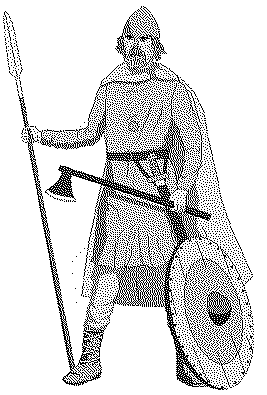 |
 |
 |
The Founding of Farthingstone |
When "the Great Army" of the Vikings divided up English Mercia in 877, a divisional commander named Farthegn seized an Anglian village in Northamptonshire and became it's overlord. The village became known as Farthegn's Tun (tun: village). Farthegn's purpose was to create a protective screen behind which a more intensive Scandinavian colonization could take place. Soldiers of the Viking army and immigrant-farmers from Scandinavia soon followed and proceeded to farm the land and raise families. The chronicler John of Wallingford complained sourly that the Danes were always combing their hair, changing their underwear and taking baths on Saturday "in order to overcome the chastity of the English women and procure the daughters of noblemen as their mistresses." Farthegn continued to be a part of the military elite, overseeing the peaceful settlement of his countrymen within what was to become known as the Danelaw. However, friction between this military elite and the English residents may be revealed by the fact that in Northamptonshire the word dane became a term of reproach meaning 'a red-haired man', (presumably because so many of the newcomers had reddish-blond hair). By the 13th century Farthegn's Tun was starting to be called Farthingstone. Other Scandinavians that left their names on the landscape around Farthingstone were Api (Apethorpe), Arnkel (Arksome), Asi (Achurch), Aski (Ashby), Bukki (Long Buckby), Faxi (Faxton), Katr (Catesby), Klyppr (Clipston), Kori (Corby), Geiti (Geddington), Grimr (Grimscote), Gunni (Gunthorpe), Halfdan (Holdenby), Hreitharr (Rothersthorpe), Maccus (Maxey), Nafarr (Navisford), Strikr (Strixton), Vikingr (Wigsthorpe), Villi (Wilby), and Ulfr (Ullesthorpe). Over half of these Scandinavian personal-names became the names of royal moneyers that minted coins for the king. Many of them survive today in the form of English surnames. They are: Arkell, Arkill, Arkle, Arckoll, Arkcoll, Askey, Askie, Haskey, Cates, Kates, Corey, Cory, Gait, Gaite, Gaitt, Grimes, Grime, Grimm, Grimme, Haldane, Halden, Haldin, Hallding, Holdane, Mack, Strick, Ulph, Wiking, and Wikings. Other Scandinavian settlers in Northamptonshire whose personal-names are commemorated in the form of minor names and field names were: Asbjorn, Asgautr, Asketill, Aslakr, Asmundr, Colman (Irish Scandinavian), Frani, Gamall, Gunnhildr, Gunnvor, Guthrun, Hamundr, Hrafn, Hrolfr, Ingvarr, Ketill, Ormr, Siward, Svanhildr, Sveinn, Thorgautr, Thorgot, Thorgeirr, Thorlakr, Thorolfr, and Thruthr. These personal-names also survive in the form of modern English surnames. They are: Askell, Astell, Astill, Astil, Augood, Coleman, Colman, Coulman, Collman, Eskell, Gamble, Gambell, Gambles, Gammell, Gammil, Gunnell, Gunner, Haskel, Haskell, Haslock, Hasloch, Hasluck, Hosbons, Hosburn, Hosegood, Horsegood, Hosgood,Inger, Inker, Ingerson, Kettle, Kettles, Kettless, Ketel, Kettell, Kittel, Kittle, Orme, Ormes, Oram, Orum, Orrom, Osband, Orsborn, Osbon, Osburn, Osbern, Osbourn, Osborn, Osborne, Osgood, Osmund, Osman, Osmant, Osment, Osmint, Raven, Ravens, Revan, Revans, Revens, Rolf, Rolfe, Rolph, Roalfe, Roles, Roll, Rolle, Rolles, Rolls, Roff, Roffe, Roaf, Rofe, Roof, Roofe, Rouf, Rove, Row, Rowe, Rowes, Rowles, Ruff, Rulf, Rule, Seward, Sewards, Sewart, Seaward, Saward, Saword, Sayward, Suart, Swain, Swaine, Swayn, Swayne, Swanell, Swonnell, Thurgood, Thorgood, Thurgate, Thurgar, Thurger, Thurgur, and Usborne. Previous Page......Next Page |